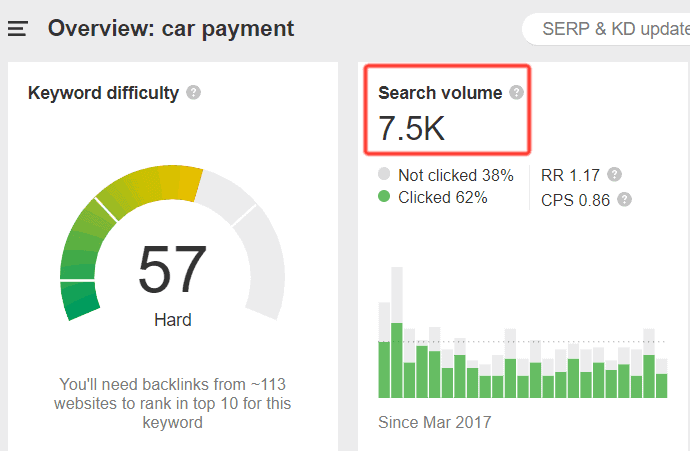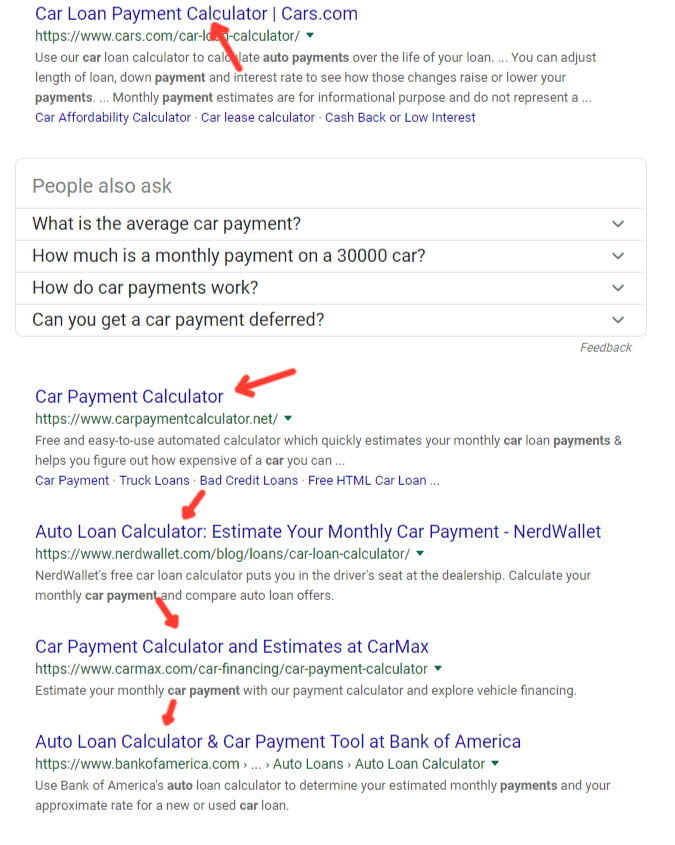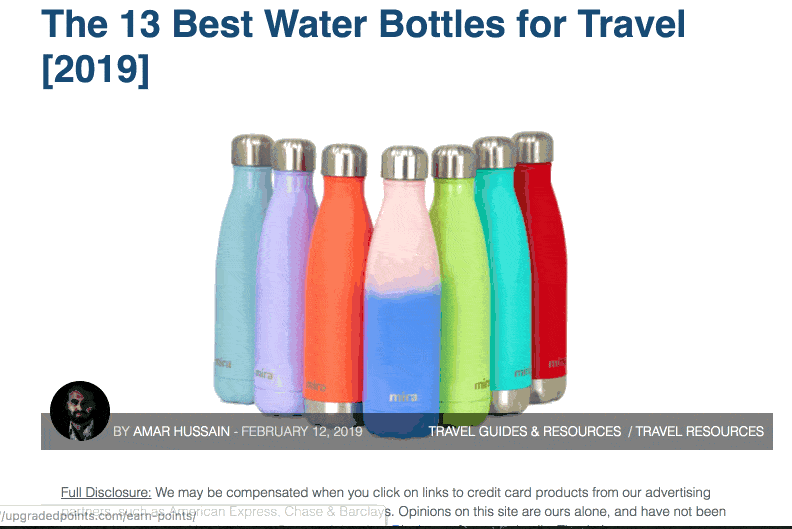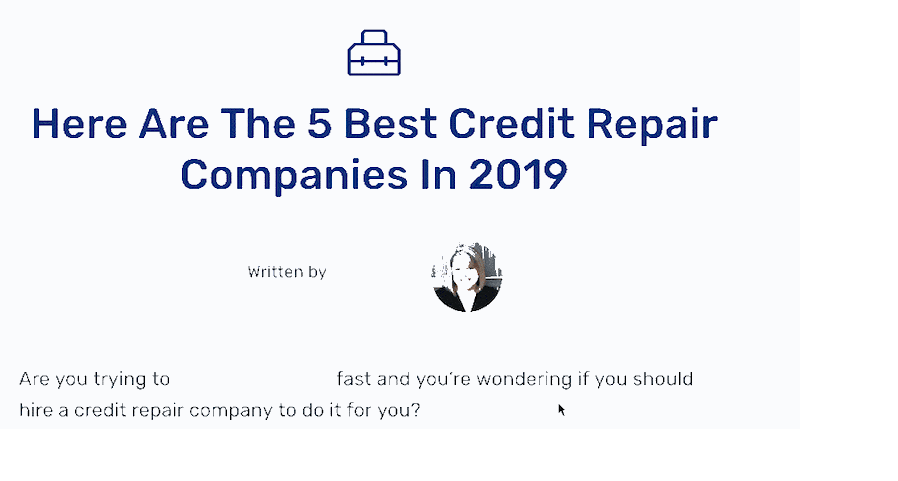How to Master “User Intent” to Improve Your SEO
Our readers always come first
The content on DollarSprout includes links to our advertising partners. When you read our content and click on one of our partners’ links, and then decide to complete an offer — whether it’s downloading an app, opening an account, or some other action — we may earn a commission from that advertiser, at no extra cost to you.
Our ultimate goal is to educate and inform, not lure you into signing up for certain offers. Compensation from our partners may impact what products we cover and where they appear on the site, but does not have any impact on the objectivity of our reviews or advice.
User intent (also known as search intent or query intent) is one of the most important components of SEO. Now, more than ever, Google is looking to display results that the user wants to see. Here's how to satisfy user intent in your content.

Our mission at DollarSprout is to help readers improve their financial lives, and we regularly partner with companies that share that same vision. If a purchase or signup is made through one of our Partners’ links, we may receive compensation for the referral. Learn more here.
User intent (sometimes referred to as query intent or search intent) is the most overlooked part of growing your blog with SEO.
Yes, on-page SEO, creating “epic” content, and building high-quality backlinks get all the attention in SEO circles these days (and for good reason). But I truly believe mastering user intent is becoming the fourth horseman when it comes to SEO.
By the end of this post, you will know:
- What user intent is
- Why user intent is so important to Google
- How to identify user intent with simple Google searches
- How to satisfy primary and secondary user intent
But first, how about a quick introduction?
Who am I and why should you listen to me?
My name is Mike Pearson. I’m a dad to two little kids, and I also manage two of my own blogs, namely, Stupid Simple SEO, where I help other bloggers grow their blog traffic with SEO.
I believe SEO is the best way to grow your traffic, and I’ve helped over 600 other bloggers do exactly that with my SEO course.
I also believe the key to SEO is to not let it intimidate you. When you break it down into its most basic concepts — great content + great backlinks = SEO success — it’s actually a pretty easy strategy not only to understand, but also to implement.
Today, we’re going to focus on the content part of SEO. Specifically, how to ensure that you’re satisfying user intent whenever you’re writing a new blog post.
What do we mean by “user intent”?
Let’s say you’re a personal finance blogger who focuses on teaching people all the different ways they can cut expenses and save money.
One day you’re doing a little keyword research in your favorite keyword tool when you come across the keyword car payment:
You see that roughly 7,500 people search for this keyword every month, according to Ahrefs.
And you know that having too big a car payment is a topic that really resonates with your audience.
Better yet, you know you can write a killer post that teaches people how they can avoiding spending too much on their car payments every month.
So you decide to target the keyword car payment in your post.
You optimize the post around that keyword, with your on-page SEO looking something like this:
Post URL: www.myblog.com/car-payments
Meta Description: Thinking about leasing that fancy car you’ve always wanted? Spending too much on your car payment every month can really bust your budget. Check out my guide to avoid falling into the car payment trap.
You hit “publish” on your post and hope for Google to rank you for the keyword car payment.
But what’s the major issue with this keyword strategy?
When people are typing the keyword car payment into Google, what are they really looking for?
Simply Googling the keyword will provide us with a pretty big clue:
Every single result on Google’s first page for the keyword car payment leads to a page with a car payment calculator.
That’s because Google has figured out the search intent behind this keyword. When someone is searching for car payment, they want to use a calculator to figure out their monthly payments.
Even if you write the most epic guide about car payments, you’re never going to rank on the first page of Google for that keyword with a piece of content.
Because that’s not what users want to see.
Why User Intent Matters for SEO
You’re probably not surprised to learn that Google is one of the five biggest companies in the world by market cap.[1] They do $100 billion in revenue per year and dominate search market share with over 90% of all web searches taking place on Google.[2]
More than 85% of their earnings come from advertising — the types of ads you see when you do a search on Google.[3]
All of this is to say that Google’s most important job is keeping you happy whenever you search for something. The more satisfied you are with their search results, the more searches you will perform on Google, and the more ad money they will generate.
So Google wants to serve up search results that make users happy, which means serving up content that matches and satisfies user intent.
Simple enough.
Google’s algorithm reflects this focus on user intent, too.
A core part of Google’s algorithm (called RankBrain) is trained to keep user intent top-of-mind when ranking pages in the search results:
“[I]t is believed that the query now goes through an interpretation model that can apply possible factors like the location of the searcher, personalization, and the words of the query to determine the searcher’s true intent. By discerning this true intent, Google can deliver more relevant results.”
Not only that, but Google uses human quality raters to help evaluate online content and provide feedback to the algorithm. As part of the guidance they provide to those human raters, they have a specific section focused on user intent:
The Bottom Line: Satisfying user intent is extremely important to Google as a company and as a search engine. Therefore, it should be incredibly important to you as a blogger and content creator.
Related: 4 Step Beginner SEO Guide to Getting Found on Search Fast
Using Google to Satisfy User Intent
Now that we know what user intent is and why it’s important for ranking in Google, let’s take a look at a couple of concrete steps you can take to ensure you’re satisfying intent when you’re creating your content.
The first step is painfully obvious but a lot of people don’t even bother doing it. It’s to Google your main keyword before you sit down to write.
So many bloggers overlook the fact that Google itself is often the best resource for doing keyword research and content brainstorming.
I’m going to walk you through a couple of things to look for in Google’s search results using a real-life example. The goal is to help you understand user intent and ultimately create better content.
Let’s say we want to create a guide and rank for the term keyword research — a ridiculously competitive term that’s relevant to my blog and my audience.
Analyzing paid ads
The first thing we want to look for is any paid ads in the search results and what those ads are promoting.
If a company is paying for placement in Google, you know they’ve done their homework. They understand why users are searching for a particular keyword and what they expect to see in the SERPs.
In our example here, you can see that SEMRush is advertising for keyword research, and they’re promoting their keyword research tool.
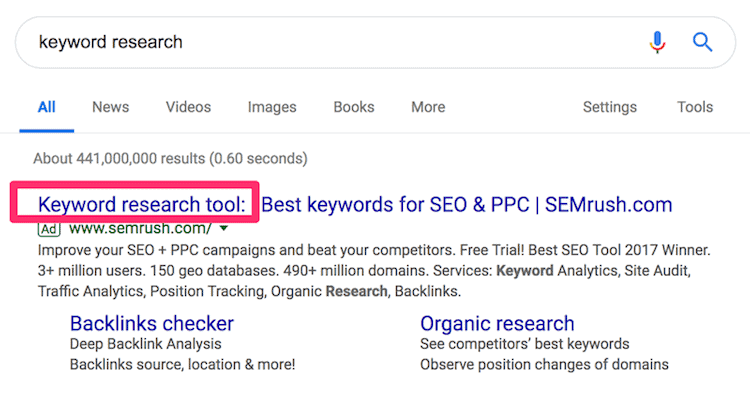
Checking the organic results
The next place I like to analyze is the organic results. In other words, the pages that are ranking in the top 10 of Google.
Here are the top ranking pages for keyword research:
Just by looking at the titles for these pages, we can infer a few things:
- Users want to read guides on how to do keyword research
- Users want to know which tools to use for keyword research (confirming our earlier finding from the paid ads)
“People also ask”
We’ve looked at the paid ads and the organic listings. Let’s move next to the “people also ask” (PAA) section of the SERPs, where you can find a lot of valuable insights.
Here’s what the PAA section shows for keyword research:

- A process for doing keyword research (including finding good keywords)
- The best tools to use for keyword research (again confirming our earlier findings)
- To know how to do keyword research without paying for any tools
“Related searches”
And then finally we want to look at the “related searches” part of the search results:
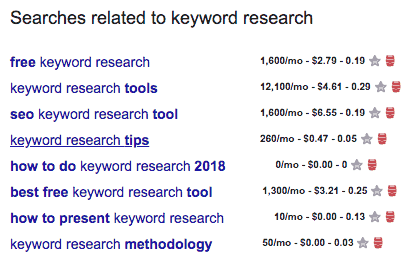
Putting all of these things together, if we’re going to write a guide and target keyword research as our keyword, here are some things we will definitely want to cover:
- A step-by-step process (“methodology”) for how to do keyword research and how to find good keywords
- A list of the best keyword research tools (free and paid) and how to use them
- Additional keyword research tips that fall outside of the process
Of course, our guide will include a lot more than that, but the above should really be the core focus. Based on our research, that’s what users want to find when they search keyword research in Google.
Related: How We Made $347,675 Blogging in Two Months
Satisfying Primary Intent
Up until this point, we’ve identified a good process for understanding the overall user intent for a given keyword. However, “overall” isn’t good enough.
While it’s great that we know what someone may be generally looking for when they land on our site, we need to get more specific. We need to be able to pinpoint exactly what they’re looking for the instant they land on our site.
When you think about it, when someone visits your blog from Google, they have a job to be done.
They have searched for something on Google. They have a problem, a question, they’re trying to accomplish something. Whatever it is, they landed on your page for one very specific reason, for one primary intent.
You need to be able to address this head-on, immediately, and specifically.
I know that may sound a little confusing, so let’s look at a few different examples.
Primary Intent Example 1: Water Bottles
Let’s say you’re a big traveler and you like to stay hydrated. You keep a water bottle with you everywhere you go, and you’re in the market for a new one. You hop onto Google and search for best water bottles for travel.
Based on everything we’ve gone over in this post already, I think it’s pretty safe to say what the primary user intent is behind this keyword. Someone wants to buy a water bottle that they can use while they’re traveling. They’re looking for a list of recommendations of the best ones.
Simple enough.
But when we Google the keyword and click into one of the top ranking results — this one was ranked #7 at the time I ran this search — we can see they’re not immediately addressing the primary intent:
You can see before we get to the actual list of the best water bottles — you know, what the user is actually searching for — we have to scroll past:
- A quick introduction (which is fine)
- A “why should you travel with a water bottle?” section
- An “impact of plastic and bottles on the environment” section, and
- A “things to consider with a water bottle” section (that’s 750 words on its own)
Only after we have scrolled through 1,307 words of extraneous content do we arrive at the point where we are trying to “do our job”.
Finally, they present us with a list of the best water bottles for travel.
But at that point, they have failed spectacularly at satisfying primary user intent. Visitors are going to bounce off their page back to the search results looking for a site that actually solves their problem.
This concept is so simple yet it’s so easy to mess up. We as bloggers are so concerned with adding extra information for word count and “comprehensiveness” purposes (which we’ll get to later) that we end up burying the lede.
I mean, think about it: if someone is searching for a list of water bottles, why are you going to make them scroll past an entire section on the impact of plastic bottles on the environment!?
There is a time and place for this kind of additional information. However, it’s not when the user first lands on your page.
So how do I recommend you address primary intent while also adding value with additional content?
Let me show you another example.
Primary Intent Example 2: Credit Repair
I just started a brand new blog in the personal finance space, in the credit niche, and one of the keywords I’m going after is best credit repair companies.
Clearly, someone searching for this keyword is primarily interested in a list of companies that they can use to repair their credit.
Again — simple stuff.
So this is how I’ve structured the beginning of my post:
I know that users want to see a list of companies, so that’s what I’ve given them. First as part of the introduction with a quick bulleted list. Then as the first main section of the post, “5 top credit repair companies”, with a brief bulleted overview of each company.
My user’s job is to find out a list of credit repair companies. That’s exactly what I intend to give them right away.
But satisfying primary intent isn’t our only goal. If that were the case, most of our blog posts would only be about 100 words long, consisting of just the “answer” to someone’s question.
No, what we want to do after satisfying primary intent is to then anticipate the next 5-10 questions our user might have and address that “secondary intent” with additional, value-added information.
See also: How to Make Your First $1,000 Blogging
Satisfying Secondary Intent
Someone searching for the keyword best credit repair company is obviously looking for a list of companies to help fix their credit. But what else are they thinking about?
What other problems do they have? What other questions do they have about credit repair and credit repair companies that I can also address on my page?
These are the kinds of things I’m thinking about when I’m building out my content and trying to satisfy secondary intent. This is where you can really structure long-form pieces of content that tend to perform well in Google because you’re able to cover a lot of related questions and topics.
For example, in my post about credit repair companies, what other questions might users have?
Going back to what we covered above, we can simply search for some keywords and see what other questions and topics Google brings back:
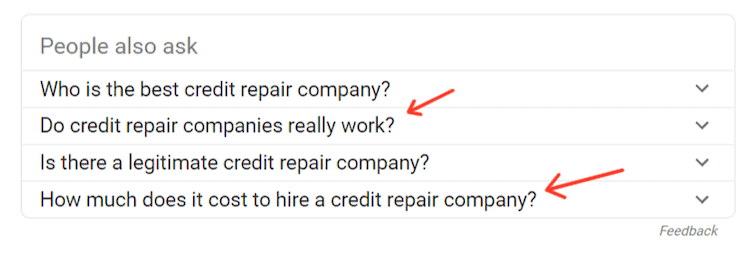
We can also anticipate what other questions someone might have (this is where knowing your niche inside and out helps).
For example, someone thinking about hiring a credit repair company might not be totally convinced it’s the right move for them yet. So I give them a few reasons why it could be helpful:
I also know this is likely their very first time hiring a company like this. That means they’re probably unsure what types of things they should watch out for. So I give them 11 things to look for:
Down and down I go through my post, addressing any other topics a user might have on their mind. The idea is that I want to answer every question they might have about this topic. That way, they don’t have to click back to the search results and visit another page.
When Google sees this kind of user behavior — that you’ve satisfied a user’s primary and secondary intent, that the user is sticking around on your page for a long time and not bouncing back to the search results — Google will return the favor and reward you with higher rankings and more organic traffic.


